Newsletter: A hydrogen hub in Utah could power L.A.’s climate future. Now Chevron wants in
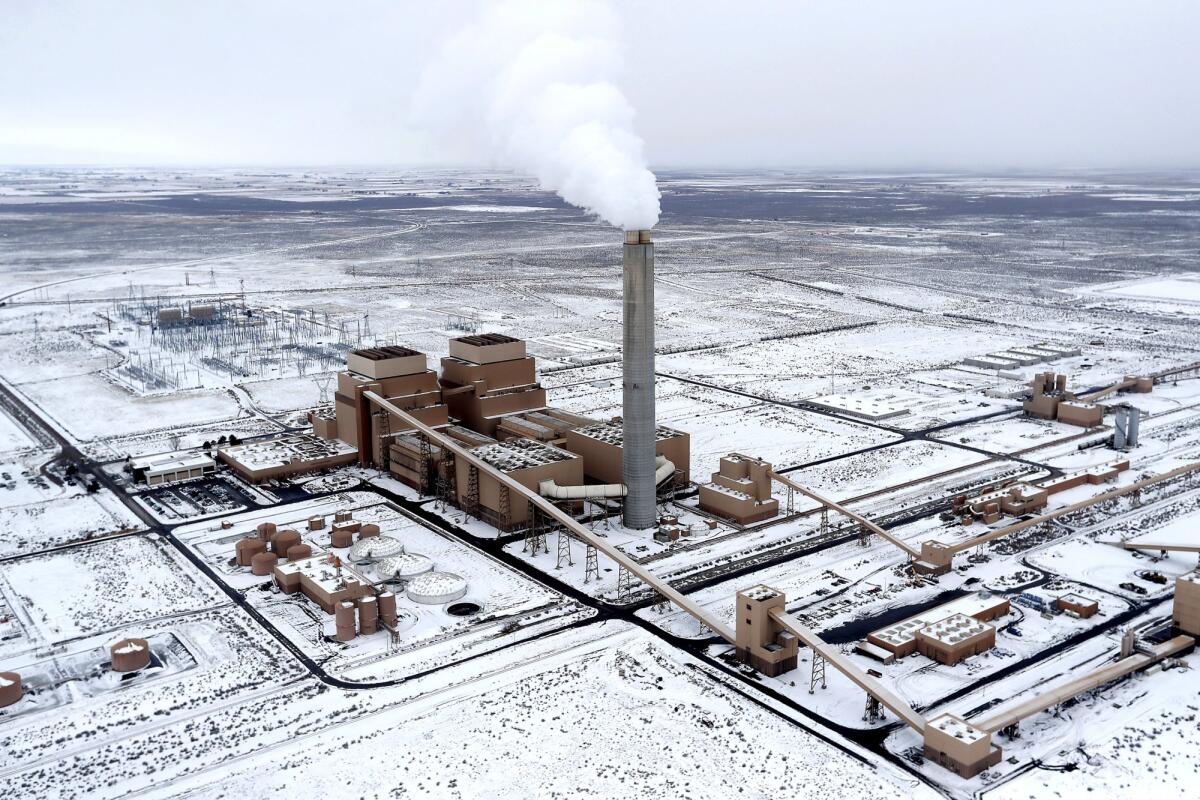
- Share via
This is the Sept. 16, 2021, edition of Boiling Point, a weekly newsletter about climate change and the environment in California and the American West. Sign up here to get it in your inbox.
The sky was overcast, the ground was covered in snow, and the air was bitterly cold as our helicopter descended toward the giant gray smokestack jutting up from the otherwise flat expanse of Utah’s Sevier Desert. The copter carried me, photographer Luis Sinco and several employees of the Los Angeles Department of Water and Power. They would be giving us a tour of the city’s single largest electricity source: Intermountain Power Plant, which burns lots and lots of coal.
Things have changed in the two and a half years since that tour.
L.A. officials and their Utah counterparts had planned to close the coal plant by 2025 and replace it with a new facility that burns natural gas, another planet-warming fossil fuel. But after I wrote about that proposal — and it was slammed by climate activists — they changed course. They said the gas plant would still be built, but its initial fuel mix would consist of 30% green hydrogen and 70% natural gas, eventually shifting to 100% hydrogen — eliminating all heat-trapping emissions.
Nothing like that has ever been done before. If all goes as planned, it will be a game-changer for the climate.
Now I’ve got another update. Chevron Corp. — one of the world’s largest oil and gas companies, headquartered in California — says it plans to invest in a related project critical to making L.A.’s hydrogen dreams a reality.
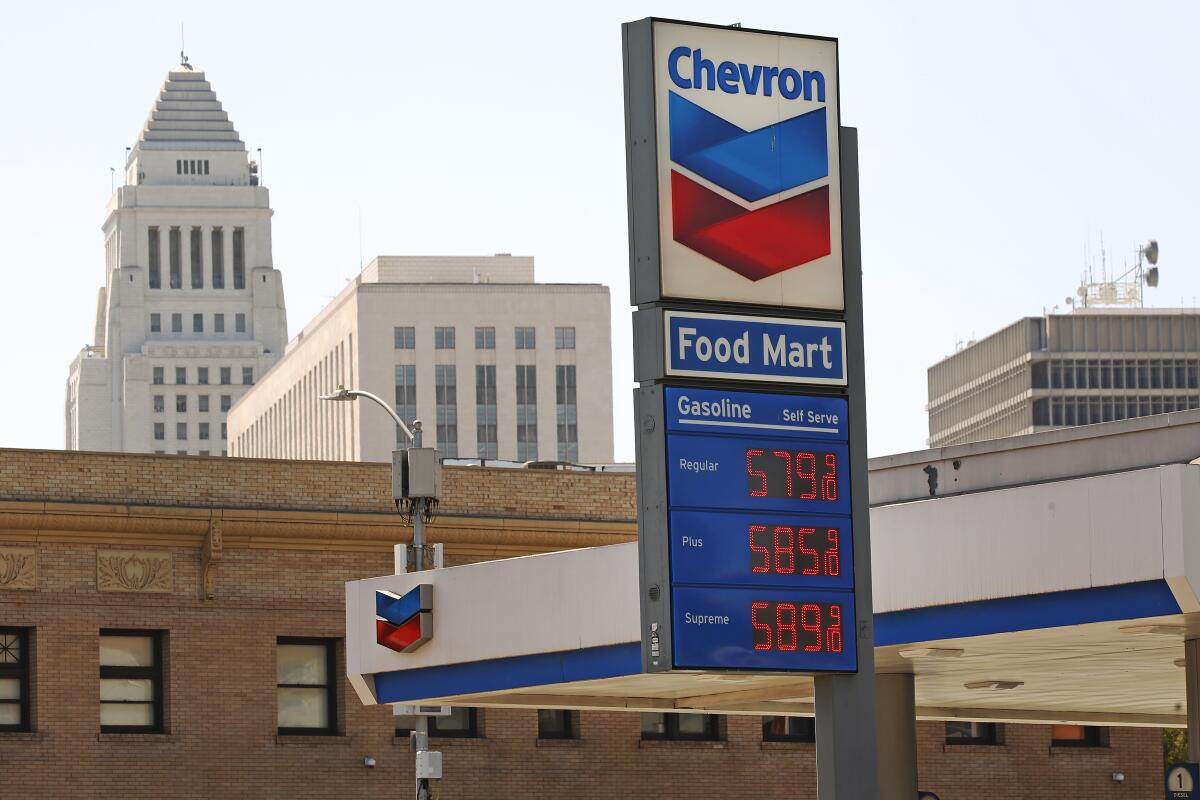
The project is called Advanced Clean Energy Storage, and it would involve pumping hydrogen into naturally occurring underground salt domes that happen to be located across the street from the coal plant — a happy coincidence, as I explained in a 2019 story. Salt domes are common on the Gulf Coast, but extremely rare out West. The project’s developer was initially focused on a different type of energy storage known as compressed air, but hydrogen has since emerged as the big-ticket item.
What makes hydrogen so attractive? It can be produced by simple electrolysis, using solar or wind power to split water molecules into hydrogen and oxygen. And it can be banked for long periods of time before being burned, essentially allowing sunlight and wind to be “stored” for times of year when those renewable power sources are not so abundant.
The Intermountain storage project is a joint venture between a subsidiary of Japanese conglomerate Mitsubishi Heavy Industries and Utah-based Magnum Development, which owns the underground salt domes. Paul Browning, president of Mitsubishi Power, told me the companies would use renewable electricity to produce hydrogen on sunny, wind days, then convert the fuel back to electricity “when it has its highest value to the grid.”
“Sometimes that’s moving power from the middle of the afternoon to the early evening,” he said. “But sometimes that’s moving power from April to October. That’s where hydrogen really has an advantage.”

Enter Chevron: The oil giant said last week it had “agreed on a framework to acquire an equity interest in” the Mitsubishi/Magnum joint venture. Chevron declined my interview request, but clearly the company brings deep pockets to the project. While Browning wouldn’t give me an overall price tag, the joint venture hopes to win a $595-million loan guarantee from the federal Department of Energy, and Browning suggested that wouldn’t cover the entire cost. So it definitely won’t be cheap.
But is Chevron serious about accelerating the clean energy transition? Or is its investment in hydrogen a delaying tactic, a way to claim it’s taking action on climate change while continuing to focus most of its energies on oil and gas?
Climate activists are skeptical. Chevron said this week it would spend $10 billion through 2028 on projects that reduce climate pollution, a tripling of its low-carbon investments. But the activist shareholder group Follow This — which recently persuaded 61% of Chevron shareholders to support a resolution calling for the California company to slash emissions from the use of its products — pointed out that Chevron would likely spend 10 times that amount overall in the coming years.
“A company that continues to spend up to 90% of their investment capital on fossil fuels cannot claim to be part of the energy transition to confront the climate crisis,” the group said in a press release.
Environmentalists also worry about oil and gas companies exploiting the promise of hydrogen to kill climate policies that could reduce pollution much more quickly. The nonprofit law firm Earthjustice cited several examples in a report last month, such as Southern California Gas arguing that cities shouldn’t require new buildings to have all-electric space and water heating, in part because hydrogen might someday be able to fully replace natural gas.
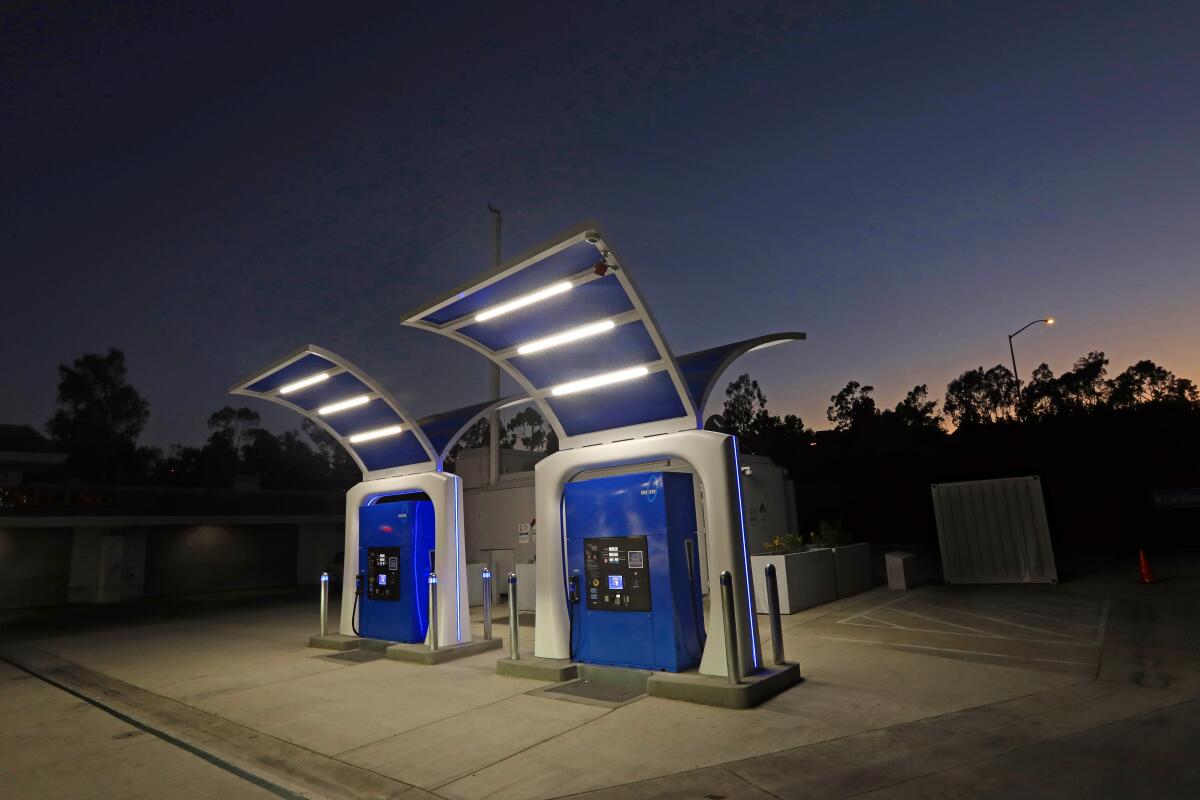
The report’s coauthors, Sara Gersen and Sasan Saadat, told me hydrogen could be crucial for ditching fossil fuels in so-called “hard to electrify” parts of the economy, such as heavy industry, aviation and shipping. But they don’t want to see it used as an excuse to block policies that would cut oil demand by requiring the rapid rollout of electric cars, or cut natural gas demand in homes and businesses by promoting the use of electric heat pumps.
“This is a larger movement in the fossil fuel industry, going from denying the fact of climate change to just delaying climate action,” Gersen said.
The Earthjustice report also notes that fossil fuels are used to produce nearly all the hydrogen in use today, unlike the “green” hydrogen that Mitsubishi and Magnum plan to produce in Utah. The report criticizes the oil and gas industry for pushing policies “that would increase hydrogen production from renewables and fossil fuels alike” and trying to obscure the difference.
But what about L.A.’s vision of shifting from coal to gas to hydrogen at its power plant outside Delta, Utah? Will that plan be a multibillion-dollar climate boondoggle, or a model for other cities and countries to follow?
It’s a unique beast, and hard to judge because nothing similar at this scale is being attempted elsewhere. Intermountain Power Plant provided 16% of the city’s electricity last year, so LADWP can’t just shut off the gas plant if hydrogen doesn’t work out — it needs that power. On the other hand, if everything does work out, there’s so much space to build underground salt caverns that Mitsubishi and Magnum could create a hydrogen hub serving customers all over the Western United States.
Browning is confident the technology won’t be an obstacle. He said Mitsubishi already makes a gas turbine that can handle a 30% hydrogen mix, and expects to have a turbine capable of burning 100% hydrogen much sooner than 2045 — possibly this decade.
“This is going to be the largest energy storage project on the planet,” he said.
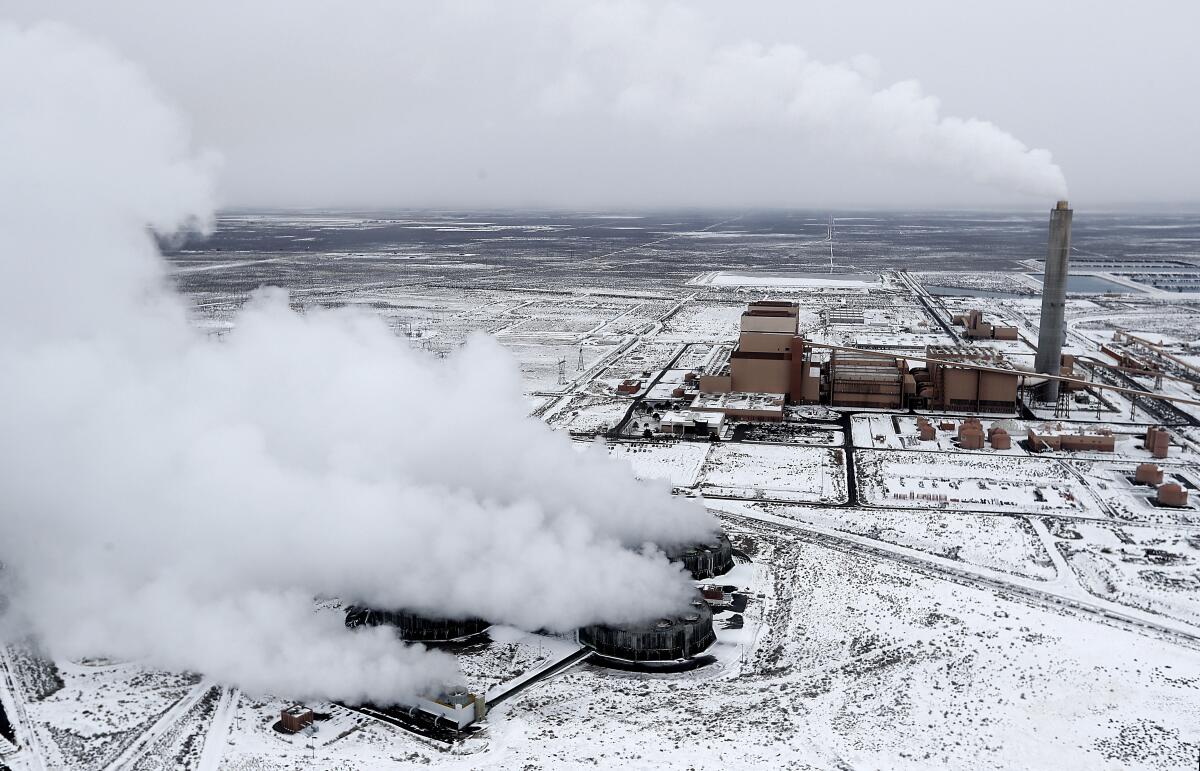
And as for Chevron? Spokesperson Tyler Kruzich told me in an email that the company “has the people, partnerships, engineering and project management expertise” to provide “the affordable, reliable and ever-cleaner energy that California needs.” He said the firm’s proposed partnership with Mitsubishi and Magnum “will be critical to delivering green hydrogen as a transportation fuel to California and other markets in the Western U.S.”
I also asked Kruzich about Assembly Bill 1395, aka the California Climate Crisis Act, which would require the state to cut emissions 90% below 1990 levels by 2045. It failed to pass this month after facing opposition from groups including the Western States Petroleum Assn., which counts Chevron as a member. Chevron lobbied on the bill, according to disclosure forms it filed.
Kruzich declined to discuss the company’s position, saying Chevron “engages with state lawmakers on a variety of proposed legislation and regulation, seeking to balance policy objectives with the need for affordable, reliable energy.”
I hope to return to Intermountain Power Plant before too long, ideally during warmer weather. Maybe by then, it will be a mecca for government officials, utility executives and clean energy entrepreneurs across the American West, all hoping Chevron and partners will sell them the world’s lightest molecule.
Or maybe it’ll still be a hulking coal plant in search of a better future. Only time will tell.
Here’s what else is happening around the West:
TOP STORIES

“We welcome this new year with renewed sense of resilience because we know that’s what’s called of us.” My colleague Robin Estrin wrote about Jewish families celebrating Rosh Hashanah after fleeing the flames that have burned across Northern California. It’s a beautiful story about hope amid chaos. So is this piece by Hailey Branson-Potts, about a beloved outdoor theater haltingly reopening in the incredibly named town of Volcano, Calif., after a lengthy closure prompted by fires and COVID-19.
“No one is suggesting that the concrete that lines the Los Angeles River be ripped out tomorrow, riverside development be damned. It can’t be done in 10 years, or probably even 20. Perhaps it’s time to start the clock on another 40-year art project.” Judith Lewis Mernit penned a gorgeous story for Red Canary Collective about L.A’s namesake river, questioning whether the city and county’s restoration plans will do much for native plants and animals. In Arizona, meanwhile, newly minted L.A. Times water reporter Ian James — in one of his last pieces for the Arizona Republic — writes that nature has come roaring back along stretches of the Santa Cruz River through downtown Tucson, thanks to the addition of treated wastewater to the riverbed.
“The greatest threat to global public health is the continued failure of world leaders to keep the global temperature rise below 1.5C and to restore nature.” That’s from an editorial published by more than 200 health journals around the world — in other world, the health professionals with the greatest expertise in this kind of thing, so we should probably listen to them. If that call to action doesn’t motivate you, try this column by The Times’ David Lazarus, who writes that climate change “means you’ll be paying more for coffee, every day, for possibly the rest of your life. And it may not taste as good.” Not great, Bob!
THE WEST ON FIRE

California saw two wildfires burn from one side of the Sierra Nevada to the other for the first time this year — and it’s a sign of things to come. New research finds that blazes are burning at higher elevations as climate change and drought dry out Western forests, making them harder to fight and threatening water supplies, The Times’ Hayley Smith reports. This year has been no exception, with California and several other Western states experiencing their hottest summers on record, Hayley reports, and the nation as a whole tying the Dust Bowl for its most scorching summer. If that’s not bad enough, California’s worst wildfires of 2021 may be yet to come, with conditions this fall looking hot, dry and windy; details here from Hayley and Lila Seidman.
Joe Biden made his first presidential trip west of Oklahoma, campaigning for Gov. Gavin Newsom — who was not recalled, by the way — and visiting the National Interagency Fire Center in Idaho and the National Renewable Energy Laboratory in Colorado. My colleagues Chris Megerian and Taryn Luna report that he took an aerial tour of California wildfire damage and said people on the East Coast struggle to understand the scale of the destruction: “It’s just unfathomable. They don’t fully understand how big the West is.” Biden also called clean energy an “economic imperative and a national security imperative,” and urged support for his $3.5-trillion spending plan that includes big climate investments, per the AP’s Alexandra Jaffe and Jonathan Lemire.
Meanwhile, quick-spreading flames continue to force evacuations and threaten ecosystems up and down California. Lila Seidman reports that the KNP Complex fires in Sequoia National Park more than quintupled in 24 hours, burning closer to groves of the largest trees on Earth. Pacific Gas & Electric, meanwhile, is being pressed by a federal judge to explain why it didn’t shut off the power line that may have sparked the Dixie fire as soon as it became clear a tree might have fallen on the line, J.D. Morris reports for the San Francisco Chronicle. One possible strategy for helping communities cope with fire? Fund better AC systems, internet access and bathrooms in public libraries, which can serve as a critical refuge, Sarah Sax writes for High Country News.
POLITICAL CLIMATE
California’s largest oil-producing county is suing Gov. Gavin Newsom over his administration’s denial of fracking permits. Details here from John Cox at the Bakersfield Californian, who notes that a Kern County spokesperson “did not respond to a question Monday about whether the oil industry is contributing to the legal effort, as happened in another county legal case.” After this newsletter was published, the county told The Times that the oil industry is not, in fact, funding the lawsuit.
A dozen climate bills went nowhere in Sacramento this year, in part due to oil and gas industry opposition. That’s according to this piece by Aaron Cantu at Capital & Main, who describes several of the failed bills. Speaking of proposals that went nowhere, Democratic gubernatorial candidate Kevin Paffrath’s campaign platform included building a pipeline from the Mississippi River to California to solve our water problems, which L.A. Times columnist George Skelton called the “dumbest idea of the recall election.”
House Democrats released the text of their $3.5-trillion spending package, and it includes tons of clean energy stuff. Jeff St. John at Canary Media had an excellent rundown on the provisions, which include funding for transmission lines and building electrification, tax credits for energy storage and financial incentives for utilities to shift quickly to renewables. Of course, the bill’s passage hinges on West Virginia Sen. Joe Manchin, who recently said he’d like to see the bill’s price tag cut by more than half.
THE ENERGY TRANSITION
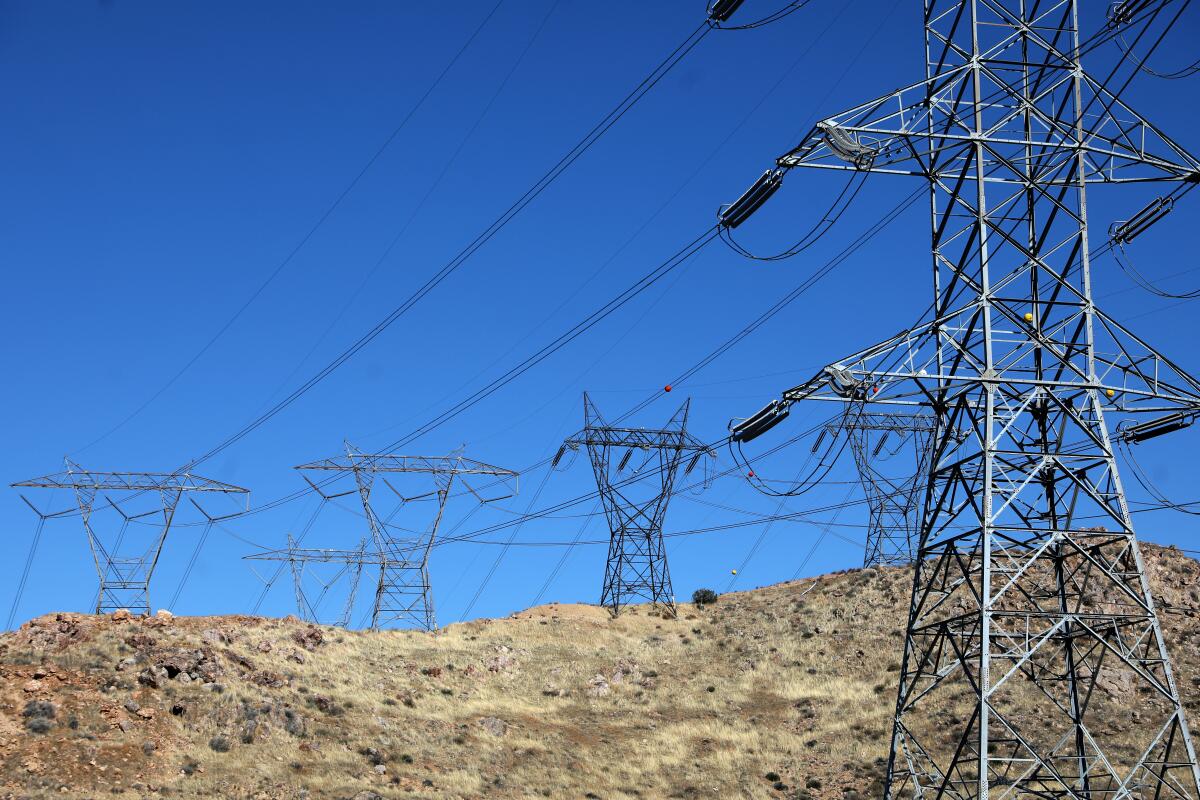
California lawmakers overwhelmingly passed a bill to promote offshore wind energy. But the legislation was stripped of provisions targeting three gigawatts of offshore wind by 2030 and 10 gigawatts by 2040, leaving the California Energy Commission to set goals instead, Mackenzie Shuman reports for the San Luis Obispo Tribune. One potential limiting factor for building offshore wind turbines: A shortage of transmission lines to carry the clean electricity across the state, as I reported earlier this year.
A major energy storage project in California overheated over Labor Day weekend, forcing it offline. Edward Klump at E&E News wrote about what went wrong at Vistra Corp.’s Moss Landing battery site. These kinds of malfunctions are rare but not unprecedented for lithium-ion batteries, and will need to be addressed if batteries are going to play a key role on the power grid.
An Arizona utility board voted 8-6 to spend nearly $1 billion on loads of new gas capacity to keep the power on when it’s hot. The Arizona Republic’s Ryan Randazzo reports that it’s been less than a month since Salt River Project staff proposed adding 16 gas generators to an existing power plant, leading critics to accuse the utility of rushing a huge investment in fossil energy.
ONE MORE THING

I had the pleasure this week of joining my colleagues Ron Lin and Alex Wigglesworth for the monthly “Masters of Disaster” panel on The Times’ daily news podcast (conveniently called “The Times”). I did my best to explain why California is having trouble keeping the lights on as the planet heats up, and to convince podcast host Gustavo Arellano that there are reasons to be hopeful.
You can listen here if you’re interested. And like I said last week, please consider supporting our journalism with a subscription.
We’ll be back in your inbox next week. If you enjoyed this newsletter, please consider forwarding it to your friends and colleagues.




